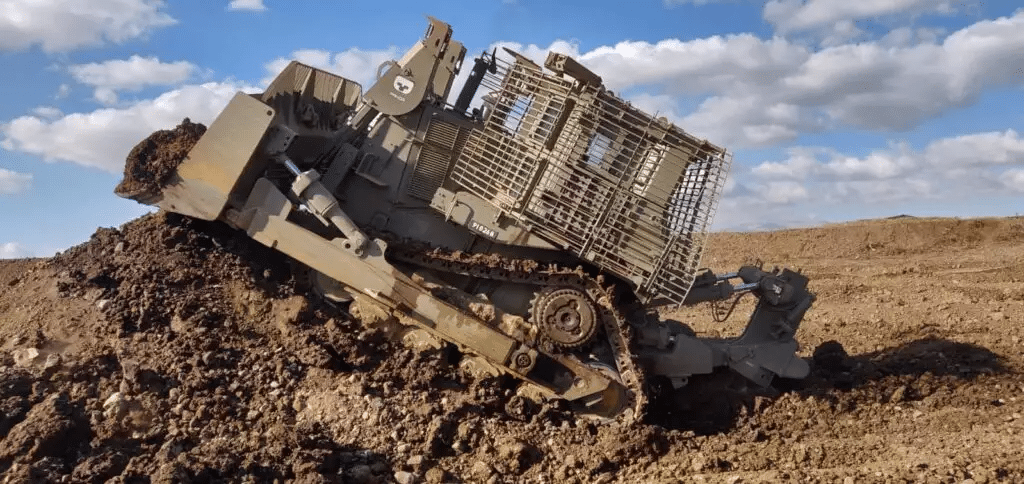Inside the IDF's robotic arsenal
RONI, Talon, and Panda: the remote-controlled vehicles the military deploys to protect soldiers and clear paths in combat zones.
Yishai Elmakies and Makor Rishon
Israel Hayom
Nov 11, 2024

Roni the robot is capable
of descending stairs, carrying weapons and entering dangerous areas
first. The Roni took a significant part in handling the Hamas tunnels
Roni the robot is capable
of descending stairs, carrying weapons and entering dangerous areas
first. The Roni took a significant part in handling the Hamas tunnels
Military historians and security analysts envision a future where robots wage war autonomously, without human presence on the battlefield. While such a scenario remains distant, the IDF has already taken substantial steps toward integrating robotic systems and remote-operated vehicles into its current combat operations.
The increasing prominence of unmanned aerial vehicles (UAVs) in warfare, with operators directing surveillance, intelligence gathering, and precision strikes from secure locations, is well documented. However, as reported by the IDF's website, the military has developed several additional ground-based autonomous systems that complement these aerial capabilities while serving distinct tactical purposes.
Within the Technology Division for the Ground Forces in the IDF, the robotics division leads efforts to transfer high-risk human operations to technological platforms, fundamentally reshaping combat doctrine. This past year has seen the enhanced integration of three primary robotic systems alongside combat units – the "Panda," the "Talon," and "RONI". These systems execute dangerous battlefield tasks without endangering personnel, utilizing advanced environmental sensors and enabling sophisticated remote operation of movement, mechanical arms, and complex tactical procedures.
"Combat situations often force units into positions of uncertainty," Captain Itai Ben-Shachar, an officer in the division, said. "Whether facing a booby-trapped structure or an underground tunnel – our robots take the first risk, preserving human life."
Describing the development process, Major Aviel Nohi, who heads the division, explained: "Field units communicate their engineering and path-clearing requirements, helping us understand what capabilities these computerized systems need. We continuously adapt our solutions based on daily operational lessons."
Panda
IDF doctrine mandates engineering clearance of all new operational zones. Traditionally, this role fell to the D9 bulldozer, carrying both an operator and commander. Since hostilities began, anti-tank missiles have struck several such vehicles and their combat engineering crews while leading advancing forces. In response, the IDF has significantly expanded deployment of the "Panda" – a remotely operated bulldozer. This system features sophisticated sensors monitoring surrounding conditions, transmitting data to operators in protected positions who clear paths for following infantry and armor units.
"The Panda proved its worth before, but in current operations, it's emerged as a decisive force multiplier," Ben-Shachar stated. "Combat experience has driven continuous improvements, including enhanced optics and more ergonomic control systems." He noted the Panda excels in large-scale operations across open terrain. "For dense urban environments or operations demanding surgical precision, we deploy alternatives like the Talon – a robust platform handling everything from mine clearance to barrier breaching."

The IDF's Panda robot.
Talon
The Talon emerged from field requirements for precise weapons neutralization and detailed engineering tasks. "Our technical analysis identified the optimal platform, which we then acquired and adapted to IDF operational, combat, and logistical specifications," Ben-Shachar explained. "Adaptations included converting the robot's communications to military frequencies and optimizing its mobility for specific combat terrain. We've implemented numerous combat-derived improvements."
This compact system handles explosives and suspicious objects with unprecedented precision, eliminating human exposure: "It autonomously identifies and neutralizes wiring and explosive components," Major Nohi said.
The Talon's capabilities extend beyond explosive ordnance disposal. Its high-speed mobility, advanced optical systems for environmental awareness, and powerful mechanical arm enable it to clear paths and move heavy obstacles, ensuring safe passage for combat units.

RONI
Responding to increasingly specific operational requirements, the robotic division developed RONI – the Hebrew acronym for Specialized Portable Robot. "It serves two critical functions – navigating confined spaces like tunnels and alleyways beyond the Talon's reach, and executing precise, sensitive engineering operations," Major Nohi explained.
Unlike its larger counterparts, RONI sees widespread deployment across various military units. This broader adoption stems from its advanced camera systems, providing protected forces with critical visual intelligence in confined spaces.
RONI's design reflects its specialized mission profile. "Its 'slipper' system – miniature support legs – enables stair climbing and obstacle navigation," Captain Ben-Shachar detailed, adding that despite its compact frame, RONI can handle loads nearly ten times its weight.
"Every requirement undergoes comprehensive analysis with weapons departments and field units, from engineering concept through technical execution," the division's leadership emphasized. "We constantly balance immediate tactical needs against future operational requirements – that's our mission."
No comments:
Post a Comment